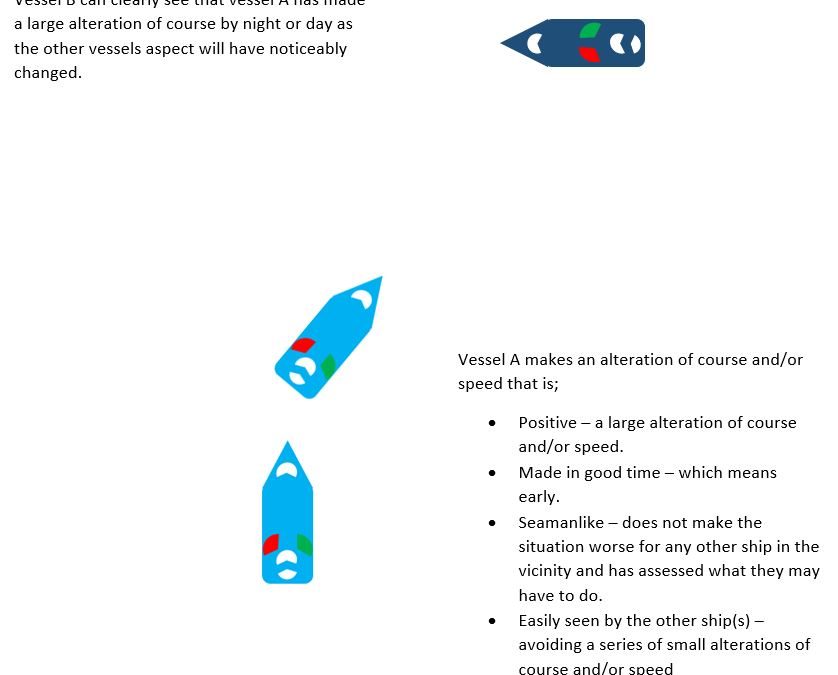Rule 8 Action to avoid Collision
EXPLANATION
(Rule 8 is below Explanation)
Take action and make it early
As soon as you identify a risk of collision, you must identify the correct action to avoid collision to ensure the vessels will pass at ‘a safe distance’. You should then take that action to avoid collision as soon as it is appropriate to do so.
· Action to avoid collision should always be:
· Positive – make a big alteration of course and/or speed.
· Made in good time – which means early.
· Seamanlike – do not make the situation worse for any other ship in the vicinity, assess what they may have to do.
· Easily seen by the other ship(s) – avoid a series of small alterations of course and/or speed.
Remember, a substantial alteration made early is better than a very large alteration made late. The closer you are to the other vessel the greater the risk of collision and the more you will have to do to pass at a safe distance. A vessel traveling at a speed of 20 knots will cover one mile every three minutes.
Small alterations of course and speed are dangerous; they do not often solve the problem and they do not give the other vessel a clear indication of what you are doing. Remember to make appropriate sound and light signals.
You should confirm your action to avoid collision by monitoring the change in CPA. Keep taking compass bearings and checking the situation until the risk of collision is over. And remember your engine – if your ability to alter course is constrained then slow down or stop IRPCS Rule 8 (e).
What is a safe distance?
Vessels crossing the busy Dover Straits may for example endeavour for a CPA with other ships of at least 1nm. The Moving Prohibited Zone in Southampton Water bans small craft from an area 1000m (0.6nm) ahead of large ships (over 150m in length) and 100m (330ft) on either side (See LOCAL NOTICE TO MARINERS No 10 of 2016 Navigation in the Approaches to Cowes: Port of Southampton – Precautionary Area 07 January 2016). In narrow channels CPA between larger vessels will be less. The larger the CPA from other vessels, the better. It is safer for all vessels concerned.
Giving way and not impeding.
If the COLREGs require you ‘not to impede’ or ‘give way to’ another vessel, then you must take very early action to make sure risk of collision does not develop.
If you are the ‘not to be impeded’ or stand-on vessel, then you must always be prepared for the give-way vessel not to take the correct action. If a risk of collision develops, you will have to act – remember the caution in Rule 2 on responsibilities and your continuing responsibilities in Rule 17 on action by the stand-on vessel. SUMMARY Always do something positive and timely to avoid a collision.
RULE 8
Action to Avoid Collision
(a) Any action taken to avoid collision shall be taken in accordance with the Rules of this Part and shall, if the circumstances of the case admit, be positive, made in ample time and with due regard to the observance of good seamanship.
(b) Any alteration of course and/or speed to avoid collision shall, if the circumstances of the case admit, be large enough to be readily apparent to another vessel observing visually or by radar; a succession of small alterations of course and/or speed should be avoided.
(c) If there is sufficient sea-room, alteration of course alone may be the most effective action to avoid a close-quarters situation provided that it is made in good time, is substantial and does not result in another close-quarters situation.
(d) Action taken to avoid collision with another vessel shall be such as to result in passing at a safe distance. The effectiveness of the action shall be carefully checked until the other vessel is finally past and clear.
(e) If necessary to avoid collision or allow more time to assess the situation, a vessel shall slacken her speed or take all way off by stopping or reversing her means of propulsion.
(f) (i) A vessel which, by any of these Rules, is required not to impede the passage or safe passage of another vessel shall, when required by the circumstances of the case, take early action to allow sufficient sea-room for the safe passage of the other vessel.
(ii) A vessel required not to impede the passage or safe passage of another vessel is not relieved of this obligation if approaching the other vessel so as to involve risk of collision and shall, when taking action, have full regard to the action which may be required by the Rules of this Part.
(iii) A vessel the passage of which is not to be impeded remains fully obliged to comply with the Rules of this Part when the two vessels are approaching one another so as to involve risk of collision.
